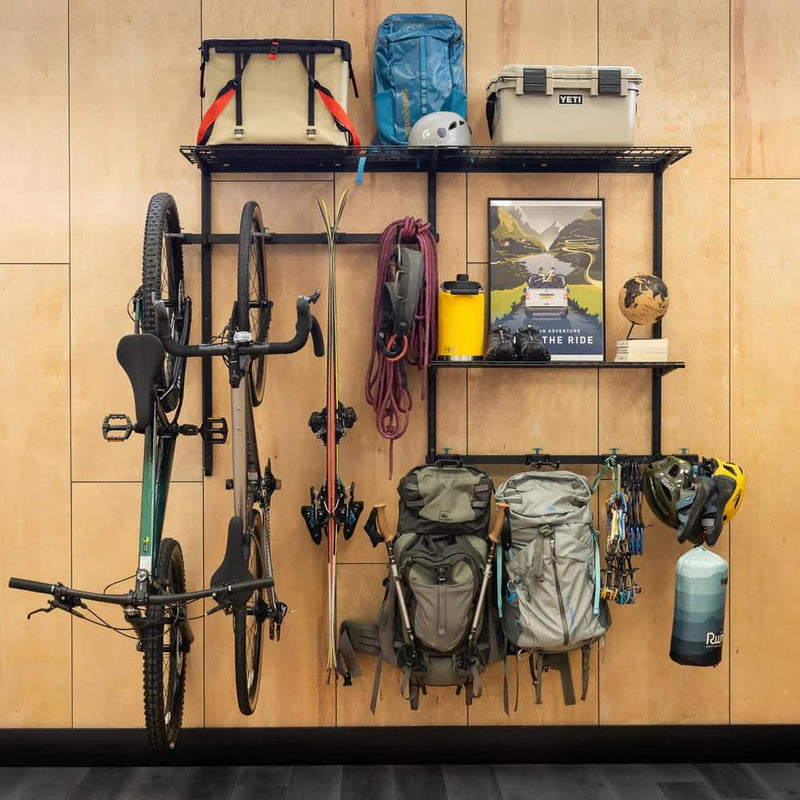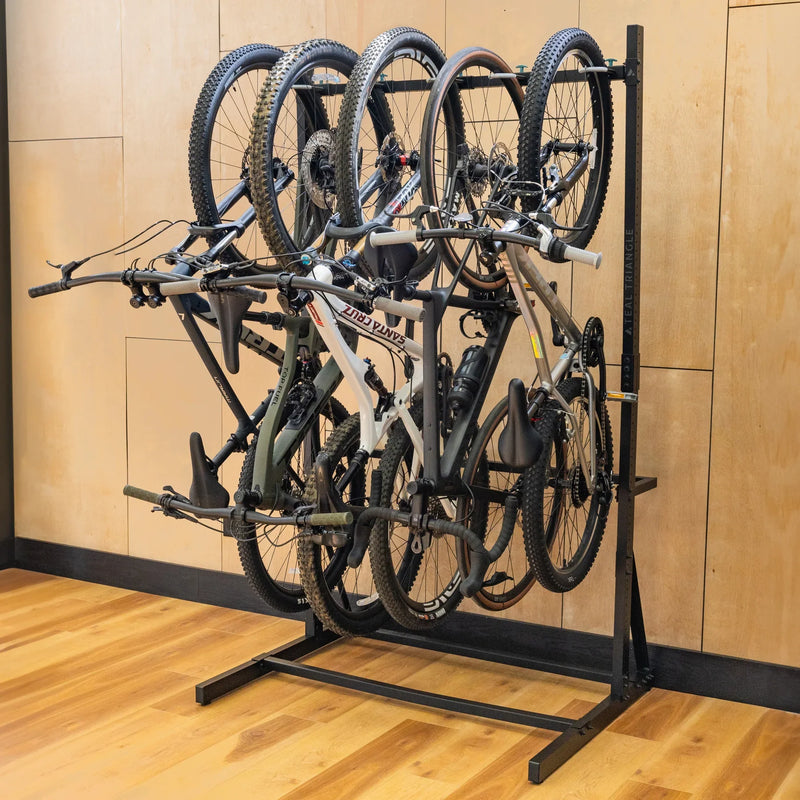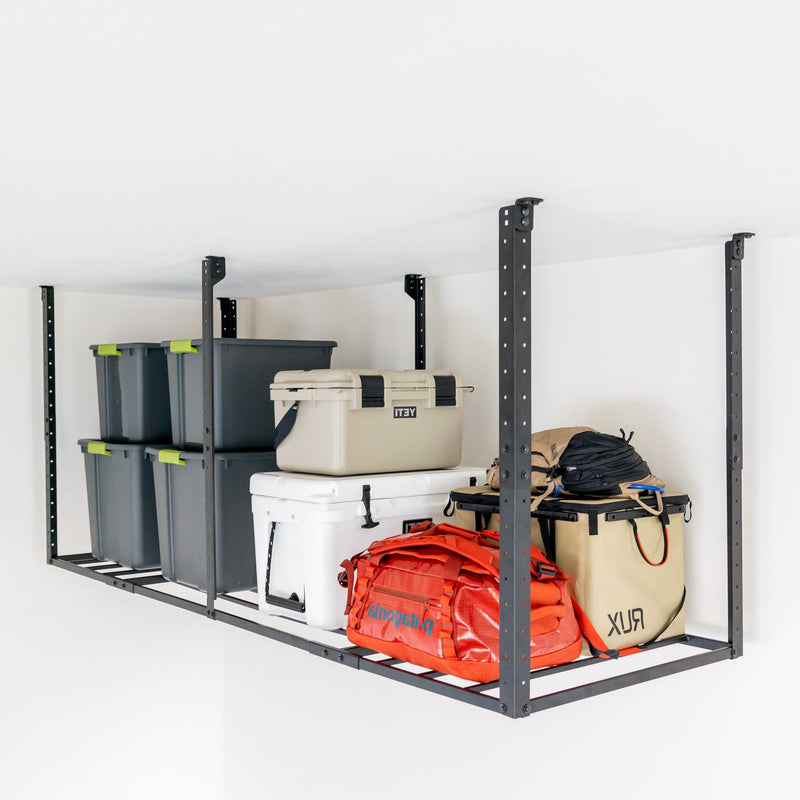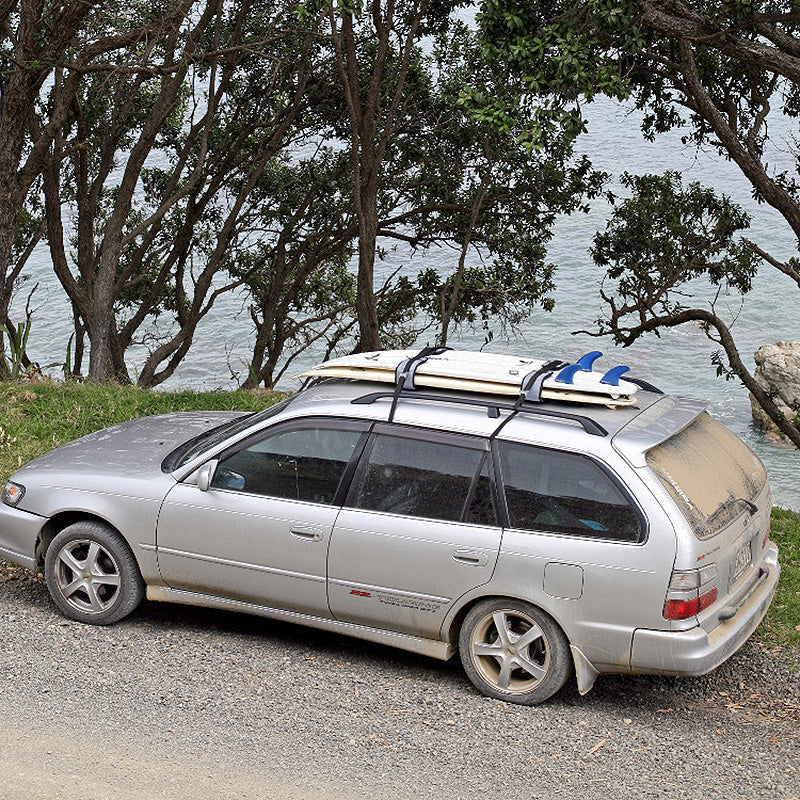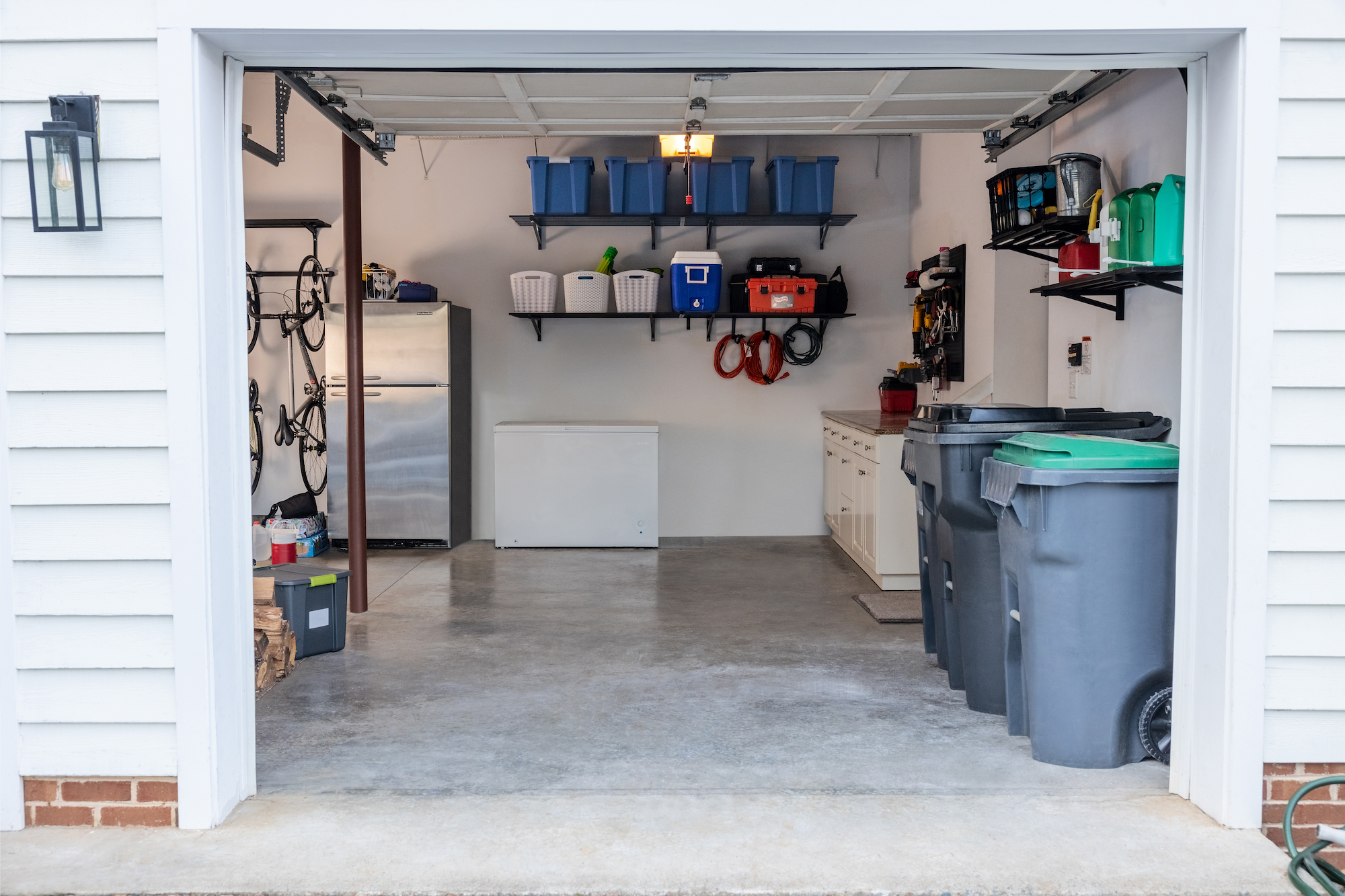As much fun as kayaks are on the water, the standard hardshell boats are bulky, large, and difficult to store when you get back home. Inflatable and folding kayaks are easily made smaller for proper storage in a cool, dry place. However, traditional kayaks need a little extra consideration to find a perfect balance between accessibility, protection, and keeping your space organized.
In this guide, we’ll cover all types of kayak storage and their benefits, straight from the organization experts at StoreYourBoard. From freestanding to wall-mounted to ceiling racks, you’re sure to find the best solutions for organizing your gear.
Overview of Storage Options
Location
- Indoor storage: Keeping kayaks indoors provides the best protection from the elements, animals, UV light, and anything else that may damage the watercraft. Depending on your space and the size of your kayaks, this may not be a practical option.
- Wall-mounted: Install a kayak storage rack into wall studs for off-the-ground storage to keep walkways clear and maintain an organized space.
- Freestanding: Allows you to move your kayak rack freely and avoid drilling holes into your walls—ideal for renters and people who want to avoid damaging their walls.
- Ceiling-mounted: Overhead kayak storage keeps kayaks organized without taking up precious wall or floor space. However, depending on the kind of rack, kayaks may not be easily accessible.
- Outdoor storage: Store kayaks outdoors so they’re close to the water for convenience and/or don’t take up indoor space. It’s important to protect your gear from the elements if stored outside.
- Wall-mounted: With racks installed on outdoor structures like sheds and decks, you can keep kayaks off the ground and keep your garage from being cluttered.
- Freestanding: Moveable outdoor storage gives you the freedom to readjust as needed. For example, keep your kayaks by the water during the summer and indoors during the winter without buying a second rack.
- Dock-mounted: The ultimate convenience—storing kayaks right on the water, where you need them.
Potential Damages from the Storage Environment
Consider the impact that your storage environment has on your watercraft. A kayak is not a cheap investment. Proper care is important to ensure that it’s usable for years to come.
To keep kayaks in tip-top shape, avoid exposure to temperature extremes, sunlight, moisture, and more.
- Heat: Extremely high temperatures can cause the kayak hull to deform, especially at pressure points where the kayak touches the storage rack. Avoid heat sources and storage in areas with the potential for extreme temperatures, such as un-air-conditioned attics and sheds during the summer months.
- Cold: You can store kayaks in the cold, but repeated freezing and thawing can cause degradation of kayak materials. Make sure the boat doesn’t fill with water and freeze—as water expands when it turns to ice, it can put pressure on your hull, causing deformation and cracking.
- Sunlight: Exposure to ultraviolet light will degrade all kayak materials, from the hull to the seat and more. Not only will it cause materials to fade, but it also causes brittleness. Direct sunlight exposure under pressure—when strapped to a car, for example—can also cause hull deformation.
- Moisture: Exposure to moisture over long periods of time can cause mold and mildew on your watercraft. It’s important to consider not just the hardshell hull, but the other non-rigid components like the seat, cushions, rigging, and more. Prolonged exposure to saltwater can accelerate damage, as well.
- Critters: Mice, ants, wasps, squirrels, snakes, and more can make a home in your kayak. Consider cleanliness and safety, as well as the potential for damage if something chews on parts of the boat—even chewing a hole right through the hull.
- Other considerations:
- Theft: Since kayaks can be quite expensive, they can be targets of theft. Consider how visible your kayak is and whether or not it needs to be locked down.
- Wind: While wind itself won’t damage a kayak, it can blow items against your kayak during storage, causing damage. And, depending on the type of kayak and how it’s stored, extreme winds could pick up and toss it.
Preventing Kayak Damages
The list of potential kayak damages may be intimidating, but there are lots of ways to keep your gear in optimal condition.
- Protect from sunlight: Keep your kayak indoors, in the shade, or covered with a tarp during storage. You can also apply a UV-protective spray to the hull, like sunscreen for your watercraft.
- Pay attention to pressure points: In combination with extreme heat, the places where your kayak meets the rack can become misshapen. Either store in less extreme temperatures or reduce pressure on the hull.
- Some single-kayak storage racks like the Roanoke Pro include straps specifically designed to reduce the pressure where kayak meets rack during storage.
- Clean and dry after use: It’s always good practice to rinse off your kayak after use, but note that saltwater is especially corrosive. If you’ve been paddling in a salty body of water, you want to be sure to hose down your kayak with fresh water to prevent degradation.
- Cover openings: Prevent water and (some larger) critters from getting inside your kayak during storage with a tarp or cockpit cover.
- Lock it down: If you’re worried about wind or theft, use bungee cords or locking cables to secure your watercraft in place.
- Many styles of kayak racks include anchor points specifically for this purpose, such as StoreYourBoard’s wall-mounted Outdoor Storage Rack and freestanding G-Watersport.
- Upside-down storage: Keeping your kayak outdoors? No problem—just be sure to either store it upside-down to prevent water collection or cover the openings with a tarp or cockpit cover.
Benefits of Outdoor Storage Types
The following is an in-depth look at the top advantages of each style of outdoor storage, along with some recommendations. Designed for weather resistance, they are a great way to save space indoors while keeping your bulky watercraft secure, tidy, and accessible.
Freestanding
- Space-efficient: Take advantage of unused outdoor space.
- The G-Watersport family offers vertical, space-saving storage for two to eight kayaks. The G-Watersport 4-Level is especially popular for holding a collection of watercraft.
- Installation-free: Avoid drilling holes into outdoor structures (perfect for renters).
- Movable: Freestanding design allows you to relocate the rack as needed, from season to season or to bring it along when you move.
- While many of these freestanding racks are movable, the G-Watersport 2-Level and 3-Level are especially convenient for relocating due to their smaller size.
- Elevated storage: Keep watercraft off the ground.
- High-capacity: Store a whole collection of kayaks or other watercraft in one place.
- The G-Watersport 8-Level is a double-sided rack that can hold up to eight kayaks—perfect for families, clubs, and more.
- Convenience: Store kayaks where you need them, whether that’s by the car for loading or by the water for paddling.
- Natural materials: While some freestanding outdoor racks are made from weather-resistant metals, others are made from logs—naturally built to withstand the elements.
- The Log Rack collection offers various sizes and finishes for outdoor kayak storage with a rustic style.
Wall-Mounted
- Versatile: Install on any surface, including fences, sheds, deck supports, boathouses, and more. With the right hardware, you can mount them on wood, concrete, and more.
- Elevated storage: Store kayaks raised and off the ground to keep them clean.
- Single or high-capacity: Find storage for a single kayak or a whole collection of them.
- The Swivel Kayak is an indoor-outdoor rack that holds one kayak, and it even swivels flat against the wall to save space when not in use.
- Space-efficient: Organized vertical storage saves you room, as opposed to on-the-ground storage that takes up floor space and creates clutter. You need less available space for wall-mounted storage than you would need for freestanding storage.
- Minimal assembly: Install onto the wall instead of assembling an entire freestanding rack.
- Rock-solid support: Install directly into wall studs for high load-bearing capacity.
Dock-Mounted
- Waterfront: Store kayaks right where you need them—on the water. With the reduced “commute” time between the rack and the water, you can get out there faster.
- Space-efficient: Reduce indoor clutter and create storage out of thin air. Dock racks that hang over the water allow you to save space on your dock or pier.
- The G-Kayak Dock Rack has an over-the-water design to keep walkways clear and allow you to store kayaks without taking over your outdoor space. Store up to 4 kayaks on it.
- Secure: Dock racks are installed directly into dock materials for secure organization.
- Elevated storage: Keeps kayaks off the ground to protect from dirt, critters, and more.
- High-capacity or single: Organize your whole collection of watercraft, or just one.
- The Marine Dockside Kayak Rack offers storage for one kayak that hangs off the edge of a dock or pier.
Benefits of Indoor Storage Types
Freestanding
- Installation-free: Kayak organization that doesn’t require drilling into your walls—ideal for renters.
- The G-Watersport 4-Level offers organization up to four kayaks stored horizontally. The freestanding design allows you to keep walls free from drill holes.
- Movable: Switch up where your rack lives. For indoor-outdoor storage racks, you can even bring them inside once kayaking season is over.
- Elevated storage: With kayaks off the ground and stored on a rack, you reduce clutter, keep them cleaner, and eliminate the danger of tripping over them.
- Protected from the elements: Indoor storage, no matter the style, keeps your kayaks safe from UV light and weather.
- Space-efficient: Raised, organized storage always takes up less room than leaving kayaks cluttered on the ground.
- The Triple Freestanding Kayak Rack holds up to three kayaks vertically, so you can get the maximum amount of storage while taking up a minimal amount of floor space.
- Accessible: Store kayaks where it’s easy to grab them and hit the water.
Wall-Mounted
- Elevated storage: Raise kayaks off the ground.
- The Indoor Kayak Storage Rack holds either two or four kayaks for raised storage that keeps them cleaner and more organized.
- Space-efficient: Keep kayaks organized when stored indoors. With wall-mounted storage, you can avoid the mess that comes with storing watercraft indoors without a storage system.
- Accessible: Kayaks will be easy to grab for hitting the water or for loading onto your car.
- Single or high-capacity: Choose between kayak wall hooks for a single watercraft and multi-kayak storage racks for a whole collection.
- Kayak holders for garage like the Roanoke Kayak Rack Standard offer horizontal storage for one kayak. It has two wall hooks for support, so you don’t need a massive storage system to organize your watercraft.
- Minimal assembly: Kayak wall hangers often involve less assembly than freestanding models.
- The Swivel Kayak Rack is another kayak hanger with two hooks for horizontal storage. With so little assembly, you can transform your space in just minutes.
- Reduced pressure points: Some kayak wall mount storage racks include safety straps to reduce the amount of pressure where the kayak meets the rack.
- The Roanoke Pro Kayak Rack includes wall brackets and straps to distribute the kayak weight more evenly and reduce pressure points during storage. This is especially important in high-temperature environments that make the kayak hull more prone to deformation.
- Protected from the elements: Indoor kayak racks keep watercraft away from the damage of UV light, moisture, critters, and accumulation of dirt or leaves.
Ceiling-Mounted
- Out-of-the-way: Overhead storage reduces clutter from keeping kayaks on ground-level. It also gives you the ability to keep your walls clear from storage racks.
- The Hi-Port offers single or double-sided ceiling kayak storage. The vertical posts are adjustable, so you can get the rack further from or closer to the ceiling. This is perfect for tucking kayaks away in the space above the garage door to really take advantage of previously unusable space.
- Elevated storage: Raise kayaks off the ground for cleanliness, safety, and tidiness.
- Space-efficient: Make use of often-unused garage space—the ceiling. Many ceiling storage solutions allow you enough space to park a car underneath. You can even put some over garage doors.
- The Essential Kayak Hoist is a compact pulley system made for lifting watercraft and other gear overhead to keep your garage organized. With a rope to raise and lower, it’s easy to grab your gear when you need it.
- Rock-solid support: Install into ceiling joists for maximum strength.
- Motorized lifts: Raise kayaks single-handedly, without the need for ladders. With the touch of a button, you can store kayaks up and away.
- The Universal Lifter uses a Bluetooth app to control the motorized lifting and lowering of your kayak. With auto-leveling and weight-sensing technology, it has never been easier to store kayak overhead and save space.
- Protected from the elements: Preserve the longevity of your kayaks with indoor, off-the-ground storage. This protects them from accumulating dust and dirt on the ground. At the same time, they will be shielded from UV damage, moisture, and more.
Conclusion
Storing kayaks properly is the key to taking care of them for longevity and keeping your space organized. Whether you’re looking for dock-mounted racks for easy grab-and-go adventures or tucked-away indoor ceiling storage for the off-season, there are options for all types of settings and space needs.
It’s important to take into consideration your needs: the size of your space, the number of kayaks you have, and how often you plan to take them out are all major factors in determining the most efficient storage for your scenario. Everyone and their kayaks are different, but luckily we at StoreYourBoard have an assortment of any type of storage you may need.
Find the right kayak storage solutions, and feel confident knowing that your gear is protected season after season. Enjoy your paddling adventures, and reach out to us with any questions or help finding the perfect kayak storage for you.


